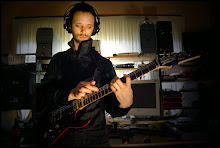Elder Conservatorium Music Tech Weekly 01/06/06
Audio Arts:
Drum kit micing:Under kill may be an appropriate way to describe the set up created by us this week. Kick, snare, room ambience and overheads were the only mics used while our resident percussionist
Patrick McCartney did his thing on the skins (damn that boy got rhythm!). I completed my recording of Tuscadero for Audio Arts on Monday night and had a total of nine mics on the drum kit. This was hardly a comparable situation though, as I had a five piece band in the space at the same time. I felt the results from Tuesday could potentially be suitable regardless of mic placement depending on the desired end result. If recording isolated drums like this, I would also be inclined to use less mics. As Hugh Robjohns suggests, close micing is only necessary where bleed is an issue.
On close inspection of the session I think it was highly beneficial to mic the snare and kick along with overheads. Soloing the overhead mics exposes a spacious but thin sound overall in my opinion (that is what this is reflecting after all). The different room positions with the Neumann offer similarities in response from the sides of the kit and between front and back. The rear is the strongest position I felt, capturing most of the kit evenly.
Creative Computing:
Basic Tape Techniques:
This week’s lecture focused on exploring the roots of sound manipulation possibilities. It’s interesting to consciously apply an approach which I would always use by default. Since my early efforts at sound recording I have understood the need to capture a good sound on tape before applying alteration effects. The theory behind this mindset can be adhered to, even when performing basic sound editing. For instance, an interesting and desirable new sound can often be created by constructing a ‘palindrome’ of an original sample by use of simple reverse and splicing tools. The ‘raw’ sound is not necessarily altered in the way it would be via use of a ‘plug in’ effect. The end result here is basically another sample available for use which is pretty much still in raw data form.
The point I, and this weeks lecture are trying to make, is that while the effect plug ins in programs like Pro-tools have their uses, they should only be used as a last resort. If you can achieve a satisfactory result without them, the quality of sound is usually more ‘solid’ and will often sound desirably organic by comparison. I’m only speaking from my own experience of course, but check out what I’ve done with Jodie Vs NIN and decide for yourself if my approach is worthwhile……
Jodie Vs NINListening Workshop:
Nobukazu Takemura – ‘Assembler’:

I coined a new word for this one ‘Xylophonic’. Digital pops seem to be making an inroad to becoming an accepted sonic tool nowdays. It contains a heavy mash of organ sounds and made impressive use of the wide frequency range offered by the instrumentation. The ending was a little abrupt….
Gut Bucket – ‘Snarling wrath of the angry gods’:
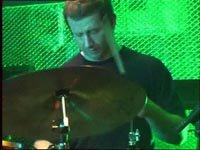
Aggressive, dare I say it: ‘grunge’ influenced prog rock. Lots of time changes and a virtuosic (if a little out there) saxophone solo. Held together very tightly for a complex arrangement…
J S Bach – ‘Six part Ricecaro’:
What can I say - I love Bach but have always been adverse to the nasally timbre of the harpsichord. Nothing has changed there. This piece seems to be pre occupied with exploring endless harmonic possibilities in every key, all the while slapping the listener with cadence after cadence and never committing to an ending. Or maybe I’m just an uneducated ignoramus - I am sitting here bagging Bach while listening to Daft Punk….
Toby Twining – ‘Kyrie’:
An accapella piece with bizarrely chosen harmonies for the human voice. Toby has done a great job of combining the deep resonance of harmonic throat singing with traditional choral styles. The wide contrast between the rhythms in individual voices is particularly effective.
Arnold Dreyblett – ‘Lapse’:
More prog influence here, with odd percussive choices and instrumentation. Dischordant harmonies are also a feature. I like the straight rock timing vs the swing thing. Very Clever.
Otomo Yosihide with John Zorm – ‘Hardcore Chinese Opera’:
The glorious sound of human torture. Very disturbing indeed.
Stravinsky – ‘Symphonies of Wind Instruments’
Although this piece is written using a block technique, it all seem to be at least rhythmically relevant. It reminded me of a film chopping between many different characters. I also found it strangely reminiscent of Saint Saeens’ Carnivale Des Animaux……am I weird?
Forum:
Vinny Bhagat:
Vinny performed a piece he’s had in the works for a few years now. It’s nice to hear some impressive D & B influenced music in between the cracks in the concrete…..
Audio exampleReference:
Robjohns, Hugh. “Recording Drums’. Sound on Sound. February issue. 2003. Pg 8 of 12.
Vinny Bhagat. "Artist Talk – Vinny Bhagat – Composing with reason." Performance presented at the Electronic Music Unit, EMU space, University of Adelaide, 01/06/2006.
Christian Haines. "Audio Arts – Drum Kit Miking". Practical Class presented at the Electronic Music Unit, EMU space, 5th floor, Schulz Building, University of Adelaide, 01/06/2006.
Christian Haines. "Creative Computing – Tape Techniques". Practical Class presented at the Audio Lab, 4th floor, Schulz Building, University of Adelaide, 01/06/2006.
Elder Conservatorium Music Tech Weekly 25/05/06
Audio Arts:
Vocal Micing was the order of the day again this week.
Jodie Mills kindly offered her services so we could test our meagre studio skills. Using the Neumann condensor microphone we started with a test take to set audio levels. Jodie is a trained classical singer with an impressive dynamic range so input gain was backed off to about half. Divider boards were used to control the reverb a little but over all it was kept pretty simple. Two recordings were made: one without compression and one with.
Decide for your self which is the better of the two.
Audio without compressionAudio with compressionCreative Computing:
The final instalment of our Pro-Tools tuition focused on some useful tools:
1) Transient select - A function to easily jump to significant transient points.
2) The difference between 'absolute' and 'relative' grids. ('Absolute' snapping to the quantisation value across the session, and 'relative' quantising from the start of the selected region - wherever it happens to be.
3) Save copy in - I'll definitely be using this one, it creates a duplicate folder of your session and all associated files, in case things get too untidy.
We have also been asked to mash the vocal recording from audio arts with NIN.
Here it is:
Jodie vs NINForum:
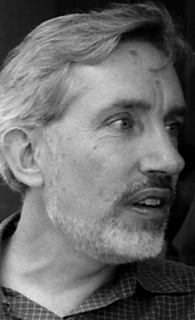 Stephen Whittington
Stephen Whittington:
Stephen, is an experienced lecturer, composer, pianist and electronic music advocate at Elder Conservatorium. He spoke today of his continuing interest in distributed music performance and the globalisation of consciousness. With a particular interest in
vocoding of the human voice, he has been involved in some challenging and diverse compositional projects. The example presented to us was a distributed performance in which the performers were situated in different parts of the world, but all playing at the same time. It featured prepared piano, accordion, and vocoded voice (spoken word) among other things. The performances were all recorded individually before being mixed together. The overall effect sounded like a microphone had been placed in an abstract pianist’s thin walled apartment, situated on a busy pedestrian street. I perceived the accordion player to be a busker playing somewhere nearby, his sound filtering through the walls and window. All the while the pianist created bizarre sounds with his prepared piano, while someone else paced around the room voicing translated i-ching text into some kind of vocoding / modulation device.
An interesting experience to say the least…..
Audio exampleDistributed music performance (DMP) is basically any performance in which the performers are not in close proximity to one another. Some links to other people and groups who are developing this concept are below. I came across the idea of DMP a couple of years ago when reading about a new product from guitar and music technology manufacturer Line 6. They now have a product called the ‘Guitar Port’ which allows musicians to jam and compose with each other over a broad band internet connection in real time. Pretty exiting stuff……
IRCAM (Institut de Recherche et Coordination Acoustique/Musique) Forum
Roger DannenburgWilliam Duckworth Spaceship earth
Spaceship earth VOIP
VOIP (Voice over internet protocol)
References:
Stephen Whittington. "Artist Talk – Stephen Whittington - Distributed Music Performance." Lecture presented at the Electronic Music Unit, EMU space, University of Adelaide, 26/05/2006.
Christian Haines. "Audio Arts – Vocal Miking". Practical Class presented at the Electronic Music Unit, EMU space, 5th floor, Schulz Building, University of Adelaide, 26/05/2006.
Christian Haines. "Creative Computing – Pro-Tools". Practical Class presented at the Audio Lab, 4th floor, Schulz Building, University of Adelaide, 26/05/2006.
Elder Conservatorium, Music Tech Weekly 18/05/2006
Forum (Listening workshop) 18/05/2006:
1.
Mr Bungle, Love is a fist:

Mike Patton is a strange man. Music taking ‘moment form’ (many musical styles in the one piece) to its compositional limits is one of his specialities. Love is a fist is certainly a far cry from the laid back jazz pop of
Faith No Mores’ cover of the Commodores ‘Easy’. Comparisons like this (and on the subject of Mike Patton there are many to be made) expose Patton’s complex and diverse approach to music making that we should all be aware of in our quest for originality.

Whether or not you like Mr Bungles’ music, you should at least devote a moment of your time to appreciate the high level of musicianship on display. There are enough time changes in this track to satisfy any
prog’ rock or complexitus leanings the listener may have. The
lyrical content is pretty harsh, reminiscent of
‘This Love’ by Pantera.
"I also do childrens birthday parties, he he he"....
Audio ExampleStockhausen, Hymnen (1966-67):

"Hello, Doctor? I think I may have a problem with my left cheekbone"......
Did I hear four hours being the vague timeframe this piece clocks in at? I’m all open to a piece composed using samples of
short wave radio discoveries, but the 20 minutes we heard at forum today should keep me happy for a while. I felt this exuded a slightly disturbing feel with the various crowd noises morphing into
analogue synth' type frequency modulation. The spoken word interlude seemed to get a bit risqué with the odd word or two in English cropping up. Overall lots of interesting sound ideas are expressed in the piece. I will take up David Harris’s advice one day and see what gems I can turn up myself with a shortwave radio.....
Audio ExampleMy Bloody Valentine, To Here Knows When:
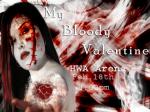
"Hello, Doctor? I also have a left cheekbone problem of sorts. While I'm here could you have a quick look at this niggling chest pain?
This is apparently ‘beauty under siege’ according to one critic. On closer sonic inspection I’m not sure that beauty alone is necessarily the way to describe the music behind the discordant multi layered drone notes. The female singer, Belinda Butcher seems to be moaning out repetitions of a I-VI-VII-VI-I bluesy melodic sequence. The rest of the band keep things rhythmically very straight with 4/4 timing, eighth note strumming of a hand full of chords, some diatonic some not etc.
A bit plain to be quoted a ‘beautiful’ arrangement I believe, but I should seek out more of their music, as the comment wasn’t directed at this piece alone. It is definitely the swirling, droning overtones that serve to make this an interesting piece of music. I just don’t think it would stand up on its own without them......
Artist Talk, Robert Chalmers:
Robert is a lawyer and Music
copyright law expert who works with Adelaide University.
The further we delved into this topic the higher my contempt for organised modern society meter rose. As a public servant who does have to refer to a government act from time to time as part of my day job, I found this a tedious subject. Must we continue down this road of making government administration more and more complex in the quest for some sort of ‘fairness utopia’? Containing music piracy is like trying to crack down on dole cheats. If you make the system highly difficult to access to protect it from such cheats, it becomes a problem for those honest people who really need it. Such ‘honest’ people can even end up being prosecuted as a result of breaching complex rules without knowing it. This problem will certainly come up in cases relating to music theft. The bottom line is that cheaters will cheat, and most of them will get away with it. I believe in the law and the purpose it serves, but I don’t believe it can be effectively and fairly enforced in many cases relating to intellectual property.
Audio Arts:
 Miking vocals
Miking vocals is on my ‘to do’ list for the next two weeks. In light of my own band experience, I also believe in a sensitive approach to handling the egos of other band members. I hope my experience as a detached sound engineer will not turn up too many issues relating to this, but time will tell.
Here is an example of me putting the dead room to bad use.....
Audio example
Reference:
David Harris. "Music Technology Workshop – Mr Bungle, Stockhausen, My Bloody Valentine". Lecture presented at the Electronic Music Unit, EMU space, 5th floor, Schulz Building, University of Adelaide, 18/05/2006.
Robert Chalmers. "Artist Talk – Music Copyright Law." Lecture presented at the Electronic Music Unit, EMU space, 5th floor, Schulz Building, University of Adelaide, 18/05/2006.
Christian Haines. "Audio Arts – Vocal Miking". Practical Class presented at the Electronic Music Unit, EMU space, 5th floor, Schulz Building, University of Adelaide, 18/05/2006.
Elder Conservatorium Music Tech Weekly 11/05/2006
Elder Conservatorium, Music Tech Weekly, 11/05/2006:
Workshop:

1.
Christian Marclay:
Strauss remix,
Hendrix remix,
Cage remix and
Maria Callas remix:
An action packed episode this week so I’ll get straight to the point. Turntable extraordinaire Christian Marclay graced the stereo with four pieces today.
The 1st was a variation on a Johann Strauss piece that I’ve always known as the ‘Whale Song’. Typical turntable manipulation techniques brought about wonderfully discordant fluctuations in timing. It sounds as if he used time stretching as a tool to help find his feet if he ever felt lost during improvisation.
 Audio Example
Audio ExampleNext was a jumble of Hendrix guitar torturing samples that would perhaps have made Jimmy proud depending on his state of mind. The focus was on dive bombing tremolo techniques, wailing string bends and anything else that didn’t resemble conventional guitar playing. The overall result is reminiscent of Jimmy’s work on ‘Third Stone From the Sun’.

"The world looks better upsidedown"........
Audio ExampleA John Cage remix created from various Cage samples sliced out of their original vinyl and glued back in a different sequence followed. The end product could have been a ‘Doof Doof’ track using audio clicks instead of drum samples. It had very consistent 4/4 timing.
Audio Example.
Opera singer Maria Callas was next on the hit list. Blending of multiple long vocal notes made for some fantastic beating frequencies and cross fading harmonic effects. A little heavy on the ears though.
 Audio Example
Audio Example2. Pink Floyd: Shine on You Crazy Diamond Pt 1 & 2:
A simple arrangement complemented by the innovative guitar style and sound of
David Gilmour. Clever use of delay, slide guitar and multi tracking seem to be key elements to the overall spaciousness and dreamy nature of these tracks. The only criticism I can muster is that the saxophone seems to be warming up for a good old shred when part 2 is fading out which leaves me wanting a little….

"Look ma, both hands"!
Audio ExampleArtist Talk:
Seb Tomczak:
Seb returned this week to speak about his honours project. It involves the creation of a new and user friendly interface for the novice who wants to get started in sound recording and manipulation (also known as music composition).
Seb is starting from an economic standpoint to make his product available to disadvantaged countries, who don’t necessarily have access to expensive hardware interface technology. The underlying premise of this is that the final product will be something the user can build themselves from readily available parts, significantly reducing the cost. It seems the format of a game controller may be a possible physical representation of the final product.
Artist Talk,
Darren Curtis:
Darren is also an honours student at Elder Conservatorium. His project for the year focuses on healing with sound via biological and neurological perspectives.
He is researching areas such as:
- Key frequencies having a direct impact on healing
- Bringing desired changes in ones psyche via sound healing
- Use of
Ultrasound,
Vibro-acoustics and
Bio computer waves
This is a project that may potentially yield exciting and revolutionary results. Darren even spoke of the possibility of cancer treatment via sound healing techniques.
The initial focus is on the manipulation of binaural beat frequencies using software such as
Max/MSP and
Supercollider.
Audio Arts:
Miking up the electric guitar? There’s a concept. I’ve been direct recording for at least five years now and had to relearn some of the cabinet miking techniques I’d forgotten. Below is an audio example of Tuesday afternoons collaborative effort between myself and Luke Digance. I was playing the house electric guitar which is still un-tuneable so I offer my apologies for all the bad notes…..
Luke D vs David DCreative Computing:
Another instalment of Pro-Tools essentials was the focus this week. I’ve been using the group track function for a long time but never knew about the 'Shift Apple Click !' function for quick group selection. Apple Click and Drag on faders for finite control is another useful one. Check the new NIN remix with updated samples, it rocks…………..
NIN RemixReferences:
Christian Haines. "Creative Computing – Pro-Tools." Lecture presented at the Audio Lab, 4th floor, Schulz Building, University of Adelaide, 11th May 2006.
Seb Tomczak. "Honors Student Presentation." Lecture presented at the Electronic Music Unit, EMU space, University of Adelaide, 11th May 2006.
Darren Curtis. "Honors Student Presentation." Lecture presented at the Electronic Music Unit, EMU space, University of Adelaide, 11th May 2006.
David Harris. "Music Technology Workshop – Christian Marclay and Pink Floyd." Lecture presented at the Electronic Music Unit, EMU space, University of Adelaide, 11th May 2006.
Christian Haines. "Audio Arts – Electric Guitar Miking Techniques." Practical Class presented at Studio 2, EMU space, 5th floor, Schulz Building, University of Adelaide, 09th May 2006.
04/05/2006 Music Tech Weekly
Led Zep @ the Music Tech Forum:
Led Zeppelin, Whole Lotta Love (1970):

Let Jimmy take over....
A brilliant old school hard rock track, it opens with a token ‘ballsy’ guitar riff composed to exploit the desirable dirtiness of tube amp distortion. Robert Plants’ distinctive vocals colour the verses and chorus with seductively (or at least tight pants) driven lyrics as the title suggests.
The interlude of this song is a rhythmic but atonal journey via use of a Theremin, various studio effects (especially delay) on the freakish guitar and vocal parts and percussion to somewhat simulate the act of coupling. Whether or not you find the result an accurate representation could perhaps be indicative of your own sex life.
It recapitulates with a simple but ingeniously effective pentatonic blues slap in the face care of the incredibly talented Jimmy Page on guitar to take it back to the verse chorus outro.
Audio Example:
Whole lottaPink Floyd, Bike:
A pop song reminiscent of the Beatles. The lyrics are humorous and rhyme well. The use of the Theremin in the chorus adds an exotic touch.
Listening to this straight after ‘Zeppelin forces some comparison as the interlude/outro of this track kicks in with very similar fashion to Whole Lotta Love even if the subject matter is different. The evil laugh at the ending is notably sinister.
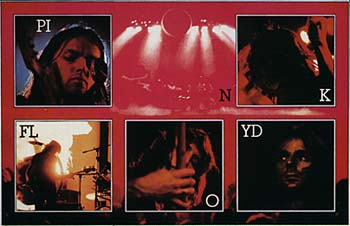 Pink Floyd
Pink Floyd, Breathe:
Composed largely with the VCS3 (the most used synthesiser of the 70’s) this contains lots of long arpeggiated phrases and Wah like frequency modulation effects. Stabbing volume fading or ‘tremolo’ type effects are also evident and of course ‘breathing samples’. This track, along with Whole Lotta Love were probably my first notable exposures to modern art music at age 14 which for some reason which escapes me, coincided with my first notable exposure to mind altering drugs………………….

Frank Zappa, Mr green genes from uncle meat:
Zappa in one of his silly moods. Nicely harmonised vocals though. Check out these
lyrics and you’ll see what I mean.
Pierre Henry, The Vale of Orpheous:
As I have felt about most of the music concrete works I have heard so far, there were elements of this piece that I appreciated more so than others. Seductive whispering by women in French is never a bad idea for instance. The use of the harpsichord however, (if that’s what it actually was) was disjointed and atonal in expression. I found the ‘Vale’ did seem to maintain a consistent feeling throughout despite cycling through many different sound sources ie; voice, bells, electronic sounds etc.
Audio ExampleArtist Talk, Tim Swalling and
Jasmine Ward:
Mimicking a process unrelated to sound and converting the found information into sound data was the order of the day here.
‘Artificial Life in the creation of music’ was an interesting concept presented by Tim and Jasmine’s process to be imitated was ‘natural waste reduction or breakdown’.
The idea of mimicking the way biological process discards redundant or weak items in favour of the strong could have desirable results in sound or music composition. After all, one of the hardest things about composing is cutting through the redundancies of an idea to expose its true strength……
Audio Arts:
Acoustic Miking techniques. Long have I desired the ability to correctly mike up my acoustic guitar. It usually records like a plywood cigar box wrapped in fishing wire.
On Tuesday I believe I came a baby step closer to my goal. I previously had no idea how a simple thing like mike placement can make all the difference.
close mic example:
mic @ 2 feet example:
Creative Computing:
More on Pro Tools this week. A few things I didn’t know I’m sure will become useful:
- Track duplicate
- Option Click function for “do to all purposes”, resetting faders and staggering channel inputs, and drag/duplication regions
- Difference between Hard and Dynamic assignment
- Plug in automation
- Auto Write, touch and Latch (Beware of auto Write!)
Check my remix of NIN for a demo of my newfound technical prowess………
Audio ExampleRefferences:
Christian Haines. "Creative Computing – Pro-Tools." Lecture presented at the Audio Lab, 4th floor, Schulz Building, University of Adelaide, 04th May 2006.
Jasmine Ward. "Honors Student Presentation." Lecture presented at the Electronic Music Unit, EMU space, University of Adelaide, 04th May 2006.
Tim Swalling. "Honors Student Presentation." Lecture presented at the Electronic Music Unit, EMU space, University of Adelaide, 04th May 2006.
David Harris. "Music Technology Workshop – Electronic Instruments in Music." Lecture presented at the Electronic Music Unit, EMU space, University of Adelaide, 04th May 2006.
Christian Haines. "Audio Arts – Acoustic Miking Techniques." Practical Class presented at Studio 2, EMU space, 5th floor, Schulz Building, University of Adelaide, 2nd May 2006.
Forum:
Iannis Xenakis,‘Voyage absoludes vnari vers andromede’:

This certainly sounds like the title suggests it should. Lots of ‘space age’ blips and early synthesiser type sound effects. I love the emphasis on pure sine waves phasing in and out of tune with each other. The dissonances produced in this piece are unusually ‘beautiful’ at least to my ears anyway. The feeling evoked is definitely one of a warp speed journey passing through different areas of space time and density.
Gabrielle Manca, ‘Inflagranti’:


Striking resemblance?
Performed by Australian guitarist Geoffrey Morris this felt like more of an exercise in developing expressive techniques with the guitar than a piece of music or organised soundscape. It seemed very random despite certain themes repeating often (such as the ascending glissando to a sharp percussive stab). Parts of this sound incredibly difficult to play and Morris is certainly up to the challenge, but knowing his capabilities inspires me to search his repertoire for something a little more traditional.
Unfortunately I wasn’t inspired to research Manca as a result of hearing Inflagranti.
Geoffrey Morris ExamplePhillip Glass, ‘Rubric’:


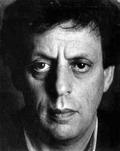
Phillip Glass contemplates the serious issues of the day.......

Phil goes off!
Fast minor 7th and suspended 4th arpeggios? Harmonised beautifully? Pushing musicians to their physical limits (especially the flutes and bass player)? What more could you possibly want from a piece of music?
Fantastic.
Phillip Glass ExampleWorkshop:
Seb Tomczak:

An honours student at Elder Conservatorium of Music, Seb is an innovative young composer who utilises technology along with random and hopefully undiscovered instrumentation techniques in his quest for creative output. As creator of the Milk Crate recording session concept (http://www.milkcrate.com.au/) he is working toward original and diverse approaches to musicianship and composition by limiting the tools one has available for creating raw sound and removing himself and other musicians from their comfort zone as artists. Once the raw sound of a session is captured by a computer various software applications are applied to the sound files as necessary to create a composition. ‘Max’ (http://sbooth.org/Max/) and ‘Plogue Bidule’ are a couple of examples; (http://www.plogue.com/index.php?option=content&task=view&id=21&Itemid=35).
There were definitely some interesting results presented to us and I believe that the nature of the Milk Crate concept will yield more and more diverse compositions for the duration of the project.
Milkcrate example:
Milkcrate ExampleCreative Computing:
Pro Tools:
I have been using Pro Tools for some years now and I am always keen to mess with other users files to see how they have utilised the system. The NIN file is relatively straightforward with a modest track number (14) to deal with and the quantity of effects and automation of parameters isn’t out of control. I’m not sure why it defaults to a short drum loop upon opening, it could have been a mistake when the original file was saved.
For a bit of fun I’ve cut up the vocal track into a few short words and sentences and synchronised it to parts of the rhythm section. I then inserted the ‘Amplitube’ plugin on the vocal track to fatten things up a little……..
Remix Audio ExampleReferences 27/04/06:
Boynick, Matthew. The Classical Music Pages. 2000. Accessed 27/04/2006. http://w3.rz-berlin.mpg.de/cmp/xenakis.html
Kirkham, Robin. Elision Ensemble. 2005. Accessed 27/04/2006.
http://www.elision.org.au/players/morris.html
ABC Classics 465 701-2. Accessed 27/04/2006
http://www.johncage.info/cdlabels/abc465701.html
David Harris. "Music Technology Workshop – Iannis Xenakis, Gabrielle Manca, Phillip Glass". Lecture presented at the Electronic Music Unit, EMU space, University of Adelaide, 27/04/2006.
Petit, Jordi. Phillip Glass. Accessed 27/04/2006.
http://www.philipglass.com/
Seb Tomczak. "Artist Talk – Milkcrate Recording Sessions." Lecture presented at the Electronic Music Unit, EMU space, University of Adelaide, 27/04/2006.
Christian Haines. "Creative Computing – Pro Tools." Lecture presented at the Audio Lab, 4th floor, Schulz Building, University of Adelaide, 27/04/2006.


























